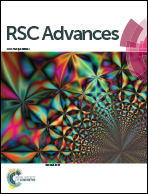Catalytic asymmetric synthesis of enantioenriched β-nitronitrile bearing a C-CF3 stereogenic center†
Abstract
CF3 substituted β-nitronitriles with an all-carbon quaternary stereogenic center have been synthesized via asymmetric cyanation reaction. In situ generated chiral TiIV salen complexes were used as catalysts for asymmetric addition of TMSCN to nitroolefins containing a trifluoromethylated prochiral center in the β-position, to afford the corresponding β-nitronitriles in excellent yield (up to 93%) with good enantioselectivity (up to 99%). This newly developed catalytic protocol led to the efficient synthesis of useful but challenging chiral α,α′-disubstituted β-amino acids.


 Please wait while we load your content...
Please wait while we load your content...